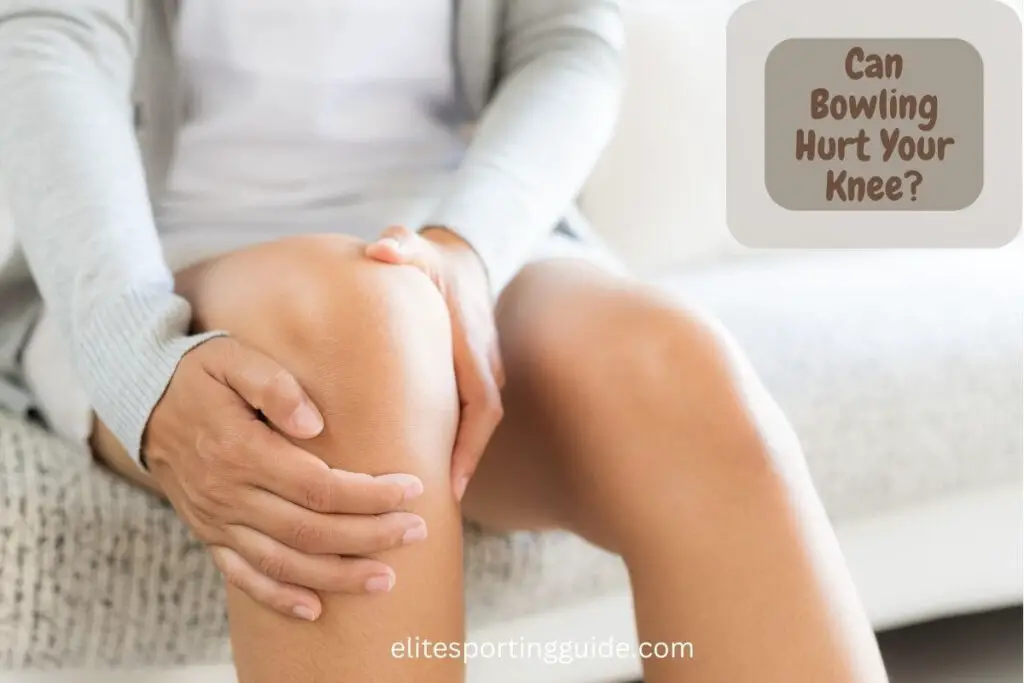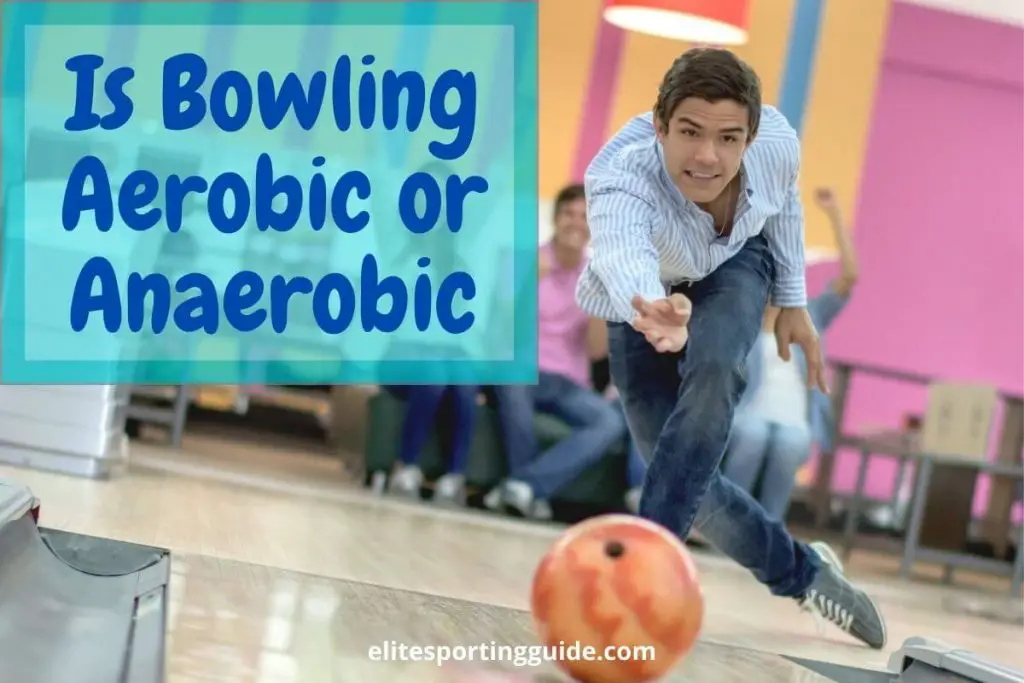In the article “Can Bowling Hurt Your Knee?”, we scour through the unexpected risks associated with a seemingly harmless activity.
Bowling is played by people of all backgrounds but little attention has been given to its potential impact on our knees.
As we explore the biomechanics of bowling and the repetitive stress it places on the knee joint, we aim to make clear what can lead to knee injuries or exacerbate pre-existing conditions.
Come with us as we uncover valuable insights and expert opinions to help enthusiasts make informed decisions about their bowling habits and overall knee health.
Can Bowling Hurt Your Knee?
Yes, bowling can potentially hurt your knee, especially if proper techniques and precautions are not followed. The repetitive motions and stress placed on the knee joint during the approach and delivery phases can lead to overuse injuries, strains, or aggravate pre-existing knee conditions. However, practicing good form, using well-fitted bowling shoes, and taking care of your knee health can significantly reduce the risk of injury while enjoying this popular pastime.
The Biomechanics of Bowling and Knee Stress
The biomechanics of bowling play a vital role in understanding the potential stress on the knee joint during this seemingly simple sport.
When a bowler approaches the lane, they execute a sequence of coordinated movements that culminate in the delivery of the ball.
During the approach phase, bowlers take several steps to build momentum, transferring energy from their body to the bowling ball.
As they near the foul line, bowlers bend their knees and flex their hips to generate power for the throw.
This dynamic and repetitive motion places significant stress on the knee joint, as it supports the body’s weight and facilitates the force required for a smooth and accurate release.
The delivery phase is particularly critical for knee stress in bowling. As the bowler releases the ball, rotational forces are generated, adding to the stress on the knee joint.
Certain bowling styles, such as those involving lateral slides or aggressive lateral push-offs, can further exacerbate knee stress due to the additional lateral forces applied during the approach.
Improper footwork or inadequate knee alignment during the follow-through can also increase the risk of knee injuries.
Common knee injuries observed among bowling enthusiasts include patellar tendinitis (jumpers knee) from repetitive jumping motions during the approach and meniscal tears caused by sharp rotational movements during the delivery.
In addition, strains or tears of the anterior cruciate ligament (ACL) result from sudden deceleration while throwing the ball.
To prevent knee injuries while bowling, it is key to focus on proper warm-up and stretching, maintain a healthy body weight, use the appropriate bowling ball weight, wear supportive shoes, practice good bowling technique, and engage in leg-strengthening exercises to better support the knee joint and reduce the risk of overuse injuries.
Common Knee Injuries in Bowling Enthusiasts
Bowling is generally considered a low-impact sport, but like any physical activity, it carries the risk of potential injuries, especially to the knees.
Some common knee injuries observed in bowling enthusiasts include:
1. Patellar Tendinitis (Jumpers Knee): This injury involves inflammation or irritation of the patellar tendon, which connects the kneecap (patella) to the shinbone.
Repetitive jumping motions during the approach phase can strain the patellar tendon, leading to pain and discomfort around the kneecap.
2. Meniscal Tears: Bowling involves sharp rotational movements during the delivery phase, and these twisting actions can sometimes cause tears in the meniscus.
The meniscus is a C-shaped piece of cartilage that acts as a shock absorber between the thigh bone (femur) and shinbone (tibia). Meniscal tears can cause pain, swelling, and limited knee movement.
3. ACL (Anterior Cruciate Ligament) Strains: The ACL is one of the major ligaments in the knee, responsible for providing stability and preventing the shinbone from sliding forward.
Sudden deceleration or stopping during the bowling motion can strain or tear the ACL, leading to severe pain, instability, and possible surgical intervention.
4. MCL (Medial Collateral Ligament) Sprains: The MCL is located on the inner side of the knee and is responsible for stabilizing the knee joint.
Bowling movements involving excessive stress or twisting can cause MCL sprains, leading to pain, swelling, and instability.
5. Chondromalacia Patella: This condition is characterized by the softening and degeneration of the cartilage under the kneecap.
Repetitive stress on the knee joint during bowling can contribute to chondromalacia patella, leading to pain and a grinding sensation when bending the knee.
6. Bowler’s Knee (Prepatellar Bursitis): This injury involves inflammation of the prepatellar bursa, a small fluid-filled sac located just above the kneecap.
Excessive kneeling during the bowling approach can cause irritation to the bursa, resulting in pain, swelling, and tenderness.
To minimize the risk of these knee injuries, bowlers should prioritize proper warm-up, use the right equipment, maintain good technique, and consider exercises to strengthen the muscles supporting the knee joint.
If any knee pain or discomfort persists, seeking professional medical advice is vital to prevent further damage and ensure a safe return to the sport.
Pre-existing Knee Conditions: How Bowling May Impact Them
Bowling, while generally considered a low-impact sport, can still have an impact on individuals with pre-existing knee conditions.
The repetitive motions and stress placed on the knee joint during bowling may exacerbate certain conditions and potentially lead to increased discomfort or injury.
Here are some examples of pre-existing knee conditions and how bowling may impact them:
1. Osteoarthritis: Individuals with osteoarthritis, a degenerative joint disease, have cartilage wear and tear in their knees.
The repetitive bending and loading of the knee during bowling can worsen the condition and lead to increased pain, stiffness, and reduced joint function.
2. Patellofemoral Pain Syndrome (Runner’s Knee): This condition involves pain in front, around or behind the kneecap and is commonly seen in athletes.
Bowling may exacerbate this syndrome due to the repetitive bending and loading of the knee during the approach and delivery phases.
3. Bursitis: Bursitis is the inflammation of the bursae, small fluid-filled sacs that cushion and reduce friction between tissues like tendons and bones.
The repeated kneeling position during the bowling approach can aggravate knee bursitis and cause pain and swelling.
4. IT (Iliotibial) Band Syndrome: The IT band runs along the outside of the thigh and can become irritated and inflamed in certain individuals.
Bowling may contribute to IT band syndrome, especially if there is poor knee alignment or improper technique.
5. Ligament Injuries: Individuals with previous ligament injuries, such as ACL tears, may find bowling stressful on their knees.
The rotational forces and sudden stops during the delivery phase can strain the healing or reconstructed ligaments, increasing the risk of re-injury.
6. Meniscal Tears: If someone has a history of meniscal tears in their knee, the rotational movements and repetitive stress of bowling may exacerbate the condition and lead to further pain and discomfort.
7. Post-Surgical Recovery: Those who have undergone knee surgeries, such as meniscus repair or ACL reconstruction, should approach bowling cautiously.
Engaging in bowling too soon after surgery or without proper rehabilitation can hinder the recovery process and potentially lead to complications.
To protect individuals with pre-existing knee conditions while enjoying bowling, it’s essential to consult with a healthcare professional, such as an orthopedic specialist or physical therapist.
They can provide personalized advice, recommend exercises to strengthen the knee, suggest modifications to bowling technique, and help determine whether bowling is safe for their specific condition.
Additionally, using knee braces or supports during bowling may offer some added stability and protection.
Ultimately, a cautious and informed approach is key to strike a balance between enjoying the sport and safeguarding knee health for those with pre-existing conditions.

Preventing knee injuries while bowling is essential to ensure long-term knee health and enjoyment of the sport.
Here are some valuable tips to reduce the risk of knee injuries:
1. Warm-up and Stretching: Before bowling, engage in a proper warm-up routine that includes dynamic stretching to increase blood flow to the muscles and prepare the knee joints for activity.
2. Maintain a Healthy Body Weight: Excess body weight can place additional stress on the knee joints.
Maintaining a healthy weight through a balanced diet and regular exercise can reduce the strain on the knees during play.
3. Choose the Right Bowling Ball Weight: Select a bowling ball that is appropriate for your strength and ability.
Using a ball that is too heavy can put unnecessary strain on the knees during the approach and delivery.
4. Wear Supportive Bowling Shoes: Invest in well-fitted, supportive bowling shoes that provide proper cushioning and stability during the approach and release.
5. Practice Proper Bowling Technique: Focus on maintaining good form and alignment throughout the entire bowling motion. Seek advice from experienced bowlers or instructors to improve your technique and reduce stress on the knees.
6. Engage in Leg-Strengthening Exercises: Strengthening the muscles around the knee joint, such as the quadriceps and hamstrings, can improve knee stability and reduce the risk of injury. Incorporate exercises like squats and lunges into your fitness routine.
7. Listen to Your Body: Pay attention to any signs of discomfort or pain in the knees. If you experience persistent pain or swelling, take a break from bowling and consult with a healthcare professional.
8. Take Regular Breaks: Give your knees time to rest and recover between bowling sessions. Avoid prolonged, continuous play that may lead to overuse injuries.
9. Implement Low-Impact Variations: Consider trying low-impact variations of bowling, such as candlepin or duckpin bowling, which can reduce the stress on the knees while still enjoying the sport.
10. Use Knee Supports if Needed: If you have a history of knee issues or are recovering from a previous knee injury, consider using knee braces or supports to provide added stability and protection.
11. Stay Hydrated: Proper hydration is essential for joint health. Drinking enough water can help keep your knees lubricated and reduce the risk of injury.
By following these tips and being mindful of your knee health, you can minimize the risk of knee injuries while bowling.
Related post: Why Does Bowling Hurt My Hip?
Proper Technique and Form: Minimizing Knee Strain
Proper technique and form are necessary for minimizing knee strain while bowling.
By focusing on the following aspects of your bowling motion, you can reduce the stress on your knees and lower the risk of injuries:
1. Balanced Approach: Maintain a smooth and balanced approach to the foul line. Avoid sudden or jerky movements that can place unnecessary strain on the knees. A controlled and consistent approach will help reduce the impact on your knee joints.
2. Optimal Footwork: Pay attention to your footwork and ensure that you are sliding and planting your foot in a controlled manner.
Avoid excessive twisting or turning of the knee during the approach phase, as this can lead to increased knee stress.
3. Bending at the Hips and Knees: When setting up for the delivery, bend at the hips and knees to lower your center of gravity.
This position will provide stability and reduce the amount of force required during the release, easing the strain on your knees.
4. Smooth Release: Focus on a smooth and controlled release of the bowling ball. An abrupt or forceful release can transmit extra impact to your knee joints. Aim for a fluid motion that follows through naturally.
5. Proper Knee Alignment: Ensure that your knees are properly aligned with your feet throughout the approach and delivery.
Avoid letting your knees collapse inward (valgus position) or excessively turning them outward (varus position), as both can increase the risk of knee injuries.
6. Avoid Overexertion: Don’t overexert yourself during bowling sessions. Take breaks between frames or games to allow your knees to rest and recover.
7. Warm-up and Stretching: Begin your bowling session with a proper warm-up, including dynamic stretches that target the muscles around the knees. This will help prepare your knees for the activity ahead.
8. Seek Professional Guidance: If you are new to bowling or want to improve your technique, consider seeking guidance from a bowling coach or experienced bowler.
They can offer valuable tips on proper form and alignment.
By implementing these techniques and focusing on proper form, you can significantly reduce the strain on your knees while bowling.
The Role of Bowling Equipment in Knee Health
Bowling equipment plays a significant role in knee health, as it can directly impact the stress placed on the knee joints during the sport.
Here are some key aspects of bowling equipment and their influence on knee health:
1. Bowling Shoes: Properly fitted and supportive bowling shoes are essential for knee health.
Bowling shoes have a sliding sole on one foot and a traction sole on the other to facilitate a smooth approach and delivery.
The sliding sole reduces the friction between the shoe and the approach surface, allowing for a controlled slide.
This controlled slide minimizes the impact on the knees during the approach phase, reducing the risk of knee strain and injury.
2. Bowling Ball Weight: Choosing the right weight of the bowling ball is pivotal for knee health.
A ball that is too heavy can place excessive strain on the knee joint during the approach and delivery.
Opt for a ball weight that you can comfortably control and release without overexerting your knees.
3. Bowling Ball Fit: Ensuring the proper fit of the bowling ball is necessary.
A ball that fits well in your hand allows for a smoother and more controlled release, reducing the need for excessive wrist or knee movements during the delivery.
4. Knee Supports and Braces: For bowlers with pre-existing knee conditions or those recovering from knee injuries, using knee supports or braces can provide added stability and protection.
These supportive devices can help reduce the stress on the knees and provide extra confidence during the bowling motion.
5. Bowling Bag: Carrying a bowling bag with the appropriate weight can also impact knee health.
A heavy bag can strain your knees, especially if you have to walk long distances to the bowling alley.
Choose a bag with wheels or use a bag that allows you to distribute the weight evenly to minimize knee strain.
6. Grip and Fit of the Shoes: Ensure that the bowling shoes fit properly and have a good grip on the sole.
A well-fitted shoe with a good grip can prevent slipping or tripping, reducing the risk of sudden knee injuries.
7. Changing Approaches: If you find that one approach style places more stress on your knees, consider trying different approaches.
Some bowlers may benefit from a more direct approach, while others may find a more lateral slide to be more comfortable and less taxing on the knees.
By investing in high-quality and properly fitted bowling equipment, you can reduce the risk of knee injuries and improve your overall bowling experience.
Alternative Approaches: Low-Impact Bowling Variations
For individuals with knee issues or those looking for low-impact bowling options, there are several alternative bowling variations that can be less taxing on the knees while still providing enjoyment and social interaction.
Here are some popular low-impact bowling variations:
1. Candlepin Bowling: Candlepin bowling is a variation predominantly played in the New England region of the United States.
The pins are thinner and taller than traditional tenpin bowling, and players use smaller, handheld balls.
The lighter weight of the balls and the less forceful throwing style make candlepin bowling easier on the knees.
2. Duckpin Bowling: Duckpin bowling is another variation that uses smaller pins and balls than traditional tenpin bowling.
The pins are short and stout, and the balls are about the size of softballs. Duckpin bowling requires less force during the approach and delivery, making it gentler on the knees.
3. Five-Pin Bowling: Five-pin bowling is a popular variation in Canada and some parts of the United States. Instead of ten pins, there are five, arranged in a V-shape.
The balls used in five-pin bowling are slightly smaller and lighter than tenpin balls, reducing the impact on the knees.
4. Bumper Bowling: Bumper bowling is an excellent option for children or individuals with knee issues who still want to enjoy the bowling experience.
The gutters are covered with inflatable bumpers, preventing the ball from going off-course.
This ensures that every roll hits pins, eliminating the need for intense lateral movements.
5. Virtual Bowling: Some bowling alleys offer virtual bowling games, where players use motion-tracking technology and lightweight balls to simulate the bowling experience.
This low-impact option allows players to enjoy bowling without physically throwing heavy balls.
6. Bowling Arcade Games: For those who prefer an even lower impact activity, bowling arcade games are a fun alternative.
These games simulate the bowling experience using virtual reality or gaming consoles, providing entertainment without the physical strain.
7. Bocce Bowling: Bocce bowling, also known as carpet bowling, is a tabletop version of bowling that uses smaller balls and can be played on various surfaces, including carpet or grass.
It is a low-impact option suitable for people of all ages.
Rehabilitation and Recovery: Healing Knee Injuries from Bowling

Recovering from knee injuries sustained while bowling requires a comprehensive rehabilitation program tailored to the specific injury and individual needs.
Here are key steps and strategies for healing knee injuries from bowling:
1. Medical Evaluation: Seek prompt medical evaluation from a healthcare professional or orthopedic specialist to accurately diagnose the knee injury’s extent and determine the most appropriate treatment plan.
2. Rest and Immobilization: Depending on the severity of the injury, the initial phase of recovery may involve rest and immobilization of the knee joint. This allows the injured tissues to heal without further strain.
3. RICE Therapy: Follow the RICE protocol – Rest, Ice, Compression, and Elevation – to reduce swelling and alleviate pain. Applying ice to the affected area for short periods can help manage inflammation.
4. Physical Therapy: Engage in a structured physical therapy program designed to strengthen the muscles around the knee, improve flexibility, and restore range of motion.
Physical therapists may use various techniques, such as therapeutic exercises, manual therapy, and modalities like ultrasound or electrical stimulation.
5. Gradual Return to Activity: As the knee heals, a gradual return to activity is crucial. Avoid rushing back into bowling too soon, as it may exacerbate the injury.
Follow the guidance of your healthcare provider or physical therapist regarding the appropriate timeline for resuming bowling.
6. Modify Bowling Technique: If the knee injury was due to improper bowling technique, work with a bowling coach or instructor to modify your approach and delivery to reduce stress on the knee joint.
7. Knee Braces or Supports: Depending on the type of knee injury, your healthcare provider may recommend using knee braces or supports during bowling to provide added stability and protection while the knee heals.
8. Pain Management: Utilize pain management techniques, such as prescribed medications or non-pharmacological methods like heat therapy, to help manage pain during the recovery process.
9. Compliance with Rehabilitation Program: Adhere diligently to your rehabilitation program and follow the advice of your healthcare provider and physical therapist.
Consistency is essential for a successful recovery.
10. Avoid Overexertion: Avoid activities that may put excessive strain on the healing knee during the recovery phase. Be patient and prioritize your knee’s well-being over rushing back into regular bowling.
11. Incorporate Low-Impact Activities: While recovering, consider engaging in low-impact activities that are less taxing on the knee, such as walking, swimming, or stationary cycling, to maintain fitness and promote circulation.
12. Regular Follow-Up: Schedule regular follow-up appointments with your healthcare provider to monitor the progress of your knee’s healing and make any necessary adjustments to your rehabilitation plan.
Every knee injury is unique, and the recovery timeline can vary. It is key to listen to your body and communicate any concerns or setbacks with your healthcare provider.
With patience, proper rehabilitation, and a focus on knee health, many individuals can successfully recover from knee injuries sustained while bowling and return to the sport they enjoy.
Related post: Can Bowling Hurt Your Wrist?
Listening to Your Body: Knowing When to Rest or Seek Help
Listening to your body is a fundamental aspect of maintaining knee health while participating in bowling or any physical activity.
Being attuned to the subtle signals your body sends can help you identify early signs of discomfort or strain in your knees.
If you experience any pain, swelling, or unusual sensations during or after bowling, it is critical to acknowledge these signals and take appropriate action.
Resting when needed and allowing your knees time to recover can prevent minor issues from progressing into more severe injuries.
If knee pain persists or worsens despite rest and self-care measures, it is essential to seek professional help from a healthcare provider or orthopedic specialist.
Timely intervention and accurate diagnosis can lead to appropriate treatment and rehabilitation, ensuring that potential knee problems are addressed promptly and effectively, allowing you to return to bowling with improved knee health and reduced risk of further injury.
Striking a Balance Between Fun and Knee Health in Bowling
Finding a balance between enjoying the fun and excitement of bowling while safeguarding knee health is of utmost importance.
Bowling is a recreational activity that brings joy to countless enthusiasts, but its repetitive motions and impact on the knee joint can lead to potential injuries.
By prioritizing proper technique, warm-up routines, and the use of appropriate equipment, bowlers can minimize the strain on their knees and reduce the risk of knee-related issues.
For those with pre-existing knee conditions or concerns, exploring low-impact bowling variations or seeking professional guidance can provide a safe and enjoyable alternative.
Additionally, being attuned to your body’s signals and knowing when to rest or seek medical help is essential for maintaining knee health.
By incorporating these practices into your bowling routine, you can continue to enjoy the thrill of bowling for years to come, while ensuring the well-being of your knees remains a top priority.



